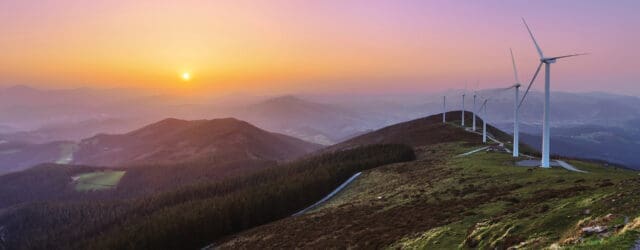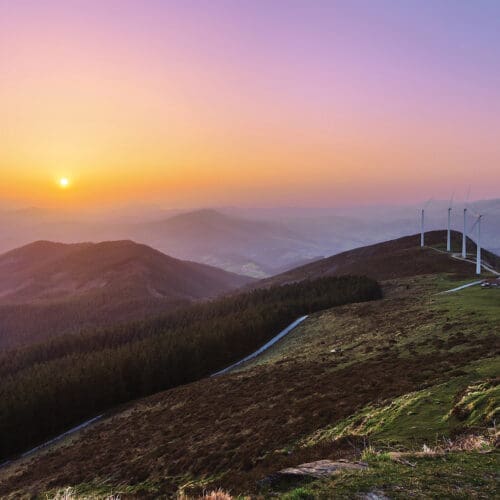Great Power, Great Responsibility: Closing Doors – Reining in Offshore Wind in Denmark
July 2023Denmark has long punched above its weight in wind. It pioneered wind power in the 1970s and gave birth to Vestas, one of the world’s largest wind turbine manufacturers, and Ørsted, one of the world’s largest developers of offshore wind projects. Both remain headquartered in Denmark, and to this day Denmark has a higher share of wind power in its energy mix than anywhere else in the world.
Another pioneering development was Denmark’s ‘open-door’ policy for renewable energy projects. This permitted developers to propose, and apply for permission to construct, new projects of their own accord, but without public subsidies. This gave developers the flexibility to set the location and capacity of their projects to suit market conditions and their own risk appetite, and meant that the Danish taxpayer was not exposed to the risks of developing those projects. The policy was hugely popular with developers of offshore wind power in particular, with some 50 applications submitted by 2022.
On 6 February 2023, the Danish Energy Agency suspended processing of all pending applications under the open-door policy. The immediate concern was the risk that the policy might conflict with EU state aid rules, and the suspension was said to be temporary pending review of that potential conflict.
At the time, applications were pending for construction of 33 projects amounting to some 15GW of capacity in total, much of which had been under development for years. The reaction from the market was overwhelmingly negative, with some calling the suspension “absurd” and noting that the open-door policy had been refined just the previous year, receiving cross-party approval in the Danish Parliament.
Closing the Door
Over the next few months, six of the 33 projects were assessed as being compatible with state aid rules and given the go-ahead. The market was hopeful that the remaining 27 projects might be permitted to proceed under a revised regime. However, those hopes were conclusively dashed in June.
On 7 June 2023, the Danish Government adopted a new marine plan. That plan governs use of Danish seas for all purposes: fishing, environmental protection zones, mining, and of course power generation. It reserves 30% of Denmark’s sea area for renewable energy projects and energy islands.
When the marine plan was adopted, areas had already been designated for three of the remaining 27 projects. However, the plan does not allocate areas for any further projects under the open-door policy which have not already been approved – in effect, meaning that the pending applications for all 24 such projects must now be rejected, and signalling the end of the open-door policy altogether.
The Danish Energy Agency will now work to adjust the open-door policy to comply with state aid rules in respect of those three projects: a market dialogue event is to take place on 10 August.
Together with the six projects previously approved, those three projects are expected to generate 3.6GW of electricity. However, the other 24 projects and 11GW of capacity are now dead, along with the open-door policy. The main question for market participants is what will replace that policy.
The New Regime
A hint had been given on 30 May 2023, when the Danish Parliament agreed a framework for the Government to tender for construction of 9GW of offshore wind power by the end of 2030. Of that 9GW, 3GW is to be constructed on Energy Island Bornholm, and 6GW elsewhere in areas now designated in the marine plan. Tenderers will be permitted to bid for ‘overplanting’ (i.e. building capacity in excess of the 9GW minimum set in the tenders), which could bring that 9GW up to 14GW in total.
On 30 June 2023, the Danish Energy Agency in collaboration with the Danish Transmission System Operator, Energinet, issued the draft procurement documents for those tenders. The first market dialogue events in the tender processes are to take place on 29 August and 6 September.
Although there is a very long way to go in the procurement process, the framework and draft procurement documents make clear the direction of travel: far more Government involvement.
In particular, although tenderers have the commercial freedom to bid for overplanting, the location and minimum capacity for each project, and the maximum timeframe for constructing and bringing the project (including any overplanting capacity) into operation are all set by the Government.
More importantly, the framework and procurement documents make clear that the Danish Government will require ownership of a of 20% stake in each project (other than those on Bornholm). The expectation is that this will be by way of a 20% equity stake in the project SPV held by a state-owned entity.
Help…?
There are clear benefits to having a national government involved in a project in this way, most importantly by ensuring that all parties’ incentives are aligned.
For one thing, approvals and permitting are perhaps the most unpredictable sources of delay on an offshore project, possibly after weather and ground conditions. Having the national government as an equity owner of the project means that the government benefits directly from approvals and permits being granted in a timely manner, which may incentivise their grant and so streamline the process.
That, in turn, provides comfort to funders and to other project participants including contractors. That comfort comes on top of the reassurance provided by the government, presumably after carrying out due diligence, having found the developer and the project investable and put its own funds on the line.
…or hindrance?
However, that comfort and reassurance comes at the cost of government interference, both at the front end and during construction. In essence, the developer will no longer be free to run the project solely with commercial priorities in mind.
At the front end, government involvement is likely to result in delay, not just during initial due diligence, but also whilst project governance arrangements are negotiated and put in place. The government may not be in a position to commit the required equity to every project as and when it is required, and that may result in further delay. There may be pressure to favour domestic manufacturers and suppliers, which could result in increased construction cost and time.
During construction, the fact that taxpayers’ money is being used in the project will result in the need to demonstrate value for money. Any variations, and any contractors’ or consultants’ applications for additional cost or extensions of time, will be closely scrutinised. If substantial, they will likely require governmental consent. That could lead to sensible variations not being put forward or approved, and could encourage contractors and consultants to pad prices up-front, thus further increasing cost.
Ownership
Furthermore the Danish Government will, as a 20% equity owner of each of these projects, be exposed to 20% of the financial risk of their performance. The goal will be for the Danish treasury to share in the upside potential of a well-performing project – if all goes well, this could be a hugely popular decision.
A project that goes wrong, however, will expose the taxpayer to losses. It will also expose the developer and other project participants to political and public scrutiny and pressure – particularly if there ends up being a choice between the government bailing out a failing project and its equity stake being diluted.
The long-running Danish experiment in commercial freedom for renewables developers is plainly at an end. The coming months and years will demonstrate whether the power of government can help accelerate the Danish energy transition, or whether it will simply prove a drag.
Download PDF







